Future-Ready Sites: Lida Group Integrates IoT Monitoring into Container Worker Dormitories Through Smart Prefab Building Systems
2025-Aug-25 10:22:47
By Admin
1. Introduction
In an era defined by digital transformation, industries are increasingly turning to smart technologies to optimize operations, enhance safety, and improve efficiency. For sectors such as construction, mining, and energy—where remote work sites and temporary worker accommodation are common—this shift toward connectivity and data-driven decision-making is particularly impactful. Traditional worker dormitories, once isolated from digital networks and lacking real-time oversight, are evolving into “future-ready sites” equipped with Internet of Things (IoT) monitoring systems.
Lida Group, a leader in prefabricated building solutions, is at the forefront of this evolution. By integrating IoT monitoring into its container worker dormitories through smart prefab building systems, the company is creating living spaces that are not just functional but also intelligent, responsive, and interconnected. These dormitories collect, analyze, and act on real-time data, enabling proactive management of everything from energy use and security to worker health and facility maintenance. This article explores how Lida Group’s IoT-integrated container dormitories are redefining temporary worker accommodation, from their technological foundations and key features to real-world applications and future potential.
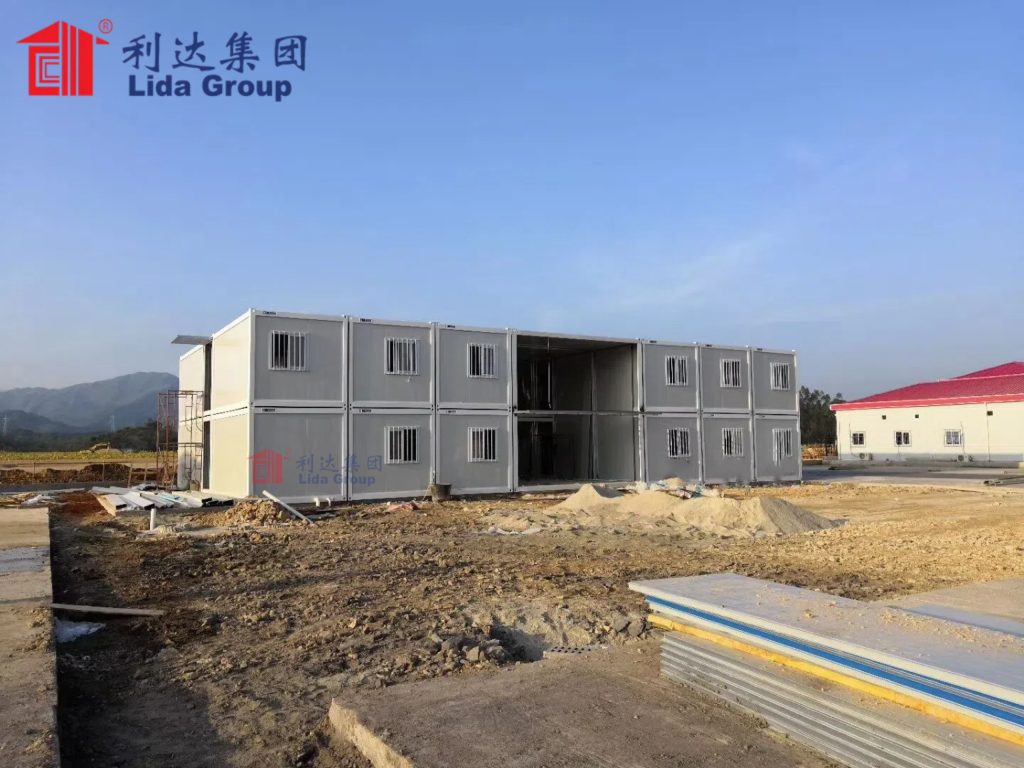
2. The Need for Smart Monitoring in Worker Dormitories
2.1. Limitations of Traditional Dormitory Management
Traditional worker dormitories rely on manual processes for management, leading to several inefficiencies:
- Reactive Maintenance: Issues such as plumbing leaks, electrical faults, or HVAC failures are often detected only after they cause disruptions, leading to costly repairs and downtime.
- Inefficient Resource Use: Without real-time data on energy or water consumption, dormitories often waste resources, driving up operational costs and environmental impact.
- Limited Security Oversight: Manual security checks and outdated access systems make it difficult to monitor unauthorized entry or respond quickly to safety incidents.
- Poor Visibility into Worker Well-Being: Managers lack insights into factors affecting workers, such as overcrowding, temperature discomfort, or air quality, which can impact health and productivity.
In remote locations, these limitations are amplified, as on-site staff are scarce and response times to issues are longer.
2.2. The Role of IoT in Addressing These Gaps
IoT technology—where physical devices (sensors, cameras, smart appliances) connect to a network to collect and exchange data—offers a solution. By embedding IoT sensors and systems into container dormitories, Lida Group enables:
- Real-Time Monitoring: Continuous tracking of conditions such as temperature, humidity, energy use, and security breaches.
- Predictive Analytics: Data analysis to forecast issues (e.g., equipment failure, high energy demand) before they occur.
- Remote Management: Oversight of dormitories from off-site locations, reducing the need for on-site staff.
- Data-Driven Decisions: Insights into resource use, worker behavior, and facility performance to optimize operations.
For industries operating in dynamic, high-stakes environments, IoT-integrated dormitories are no longer a luxury but a critical tool for efficiency and safety.
2.3. Why Prefab Container Dormitories Are Ideal for IoT Integration
Prefabricated container dormitories, with their standardized, factory-built design, are uniquely suited for IoT integration:
- Consistent Infrastructure: Factory production ensures uniform placement of sensors, wiring, and connectivity tools, reducing installation errors.
- Modular Scalability: IoT systems can be easily expanded as dormitory complexes grow, with new containers pre-equipped to connect to existing networks.
- Quality Control: Sensors and smart devices are tested in controlled factory conditions, ensuring reliability before deployment.
- Cost Efficiency: Integrating IoT during prefabrication is more affordable than retrofitting traditional buildings, as wiring and sensors are installed during manufacturing.
Lida Group leverages these advantages to create IoT-ready container dormitories that are plug-and-play, minimizing on-site setup time.
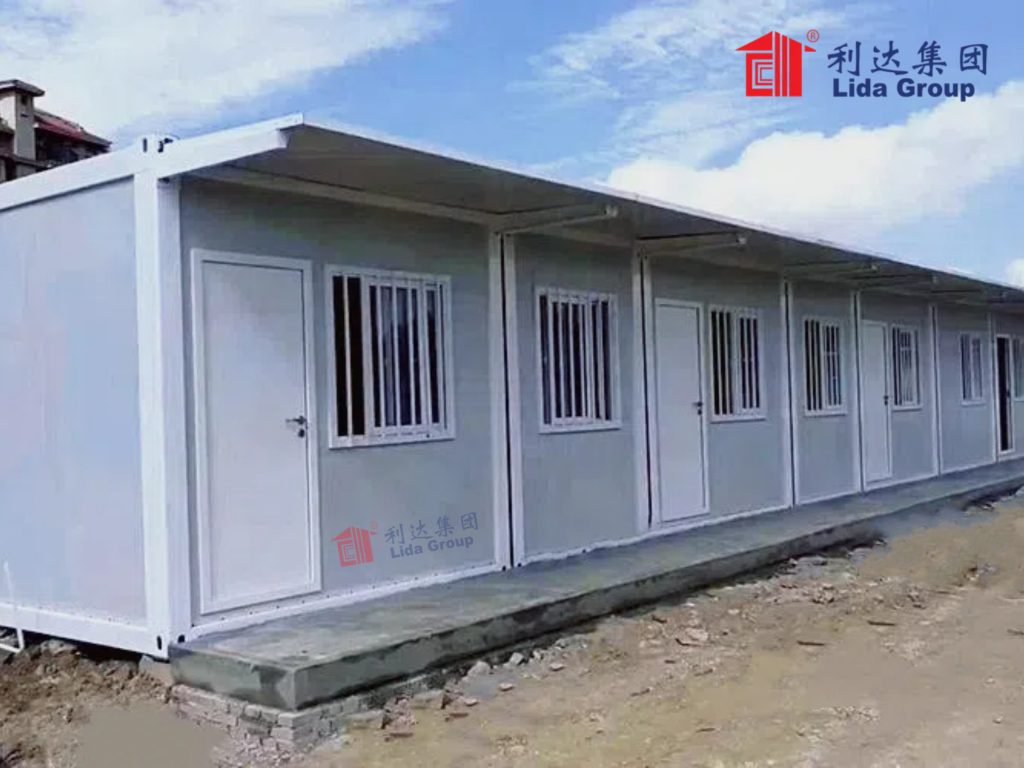
3. Lida Group’s Smart Prefab Building Systems: The Foundation of IoT Integration
3.1. Hardware Infrastructure for IoT Monitoring
Lida Group’s container dormitories include a robust hardware ecosystem designed to support IoT functionality:
- Sensors: A network of sensors is embedded throughout each container, monitoring:
-
- Environmental conditions (temperature, humidity, air quality, CO₂ levels).
-
- Resource use (electricity, water, gas).
-
- Structural health (vibration, moisture in walls, foundation stability).
-
- Security (motion, door/window openings, glass breakage).
- Connectivity Tools: Containers are equipped with Wi-Fi 6, Bluetooth, and cellular modems (for remote areas) to ensure constant data transmission. In areas with poor connectivity, edge computing devices store data locally and sync when networks are available.
- Control Interfaces: Smart thermostats, lighting switches, and security panels allow on-site adjustment, while centralized dashboards enable remote management.
- Power Backup: Uninterruptible power supplies (UPS) and solar batteries ensure sensors and connectivity tools remain operational during outages.
This infrastructure creates a seamless data pipeline from the dormitory to management systems.
3.2. Software Platforms for Data Management and Analysis
Data collected by sensors is processed and visualized through Lida Group’s proprietary software platforms:
- Centralized Dashboards: Cloud-based or on-premises dashboards display real-time data on energy use, security alerts, maintenance needs, and environmental conditions. Managers can filter data by container, zone, or time period.
- Predictive Analytics Algorithms: Machine learning models analyze historical and real-time data to predict issues, such as:
-
- HVAC failure based on unusual energy spikes.
-
- Water leaks from pressure fluctuations.
-
- High energy demand during peak hours.
- Automated Alerts: The system sends notifications (via email, SMS, or app) for critical issues, such as a security breach, abnormal CO₂ levels, or a broken pipe.
- Reporting Tools: Customizable reports on resource consumption, maintenance costs, and compliance metrics (e.g., health and safety standards) simplify audits and decision-making.
These software tools transform raw data into actionable insights, enabling proactive management.
3.3. Integration with Existing Project Management Systems
Lida Group’s IoT systems are designed to integrate with clients’ existing software, ensuring seamless workflow:
- API Compatibility: Application Programming Interfaces (APIs) allow data sharing with project management software, HR systems (for worker tracking), and enterprise resource planning (ERP) tools.
- BIM Integration: Data from IoT sensors can be overlaid on Building Information Modeling (BIM) models, visualizing issues within the dormitory’s structural design.
- Third-Party Integrations: Compatibility with popular tools such as energy management software, security systems, and maintenance tracking platforms (e.g., CMMS) ensures no data silos.
This integration ensures that dormitory data is part of a holistic project management strategy.
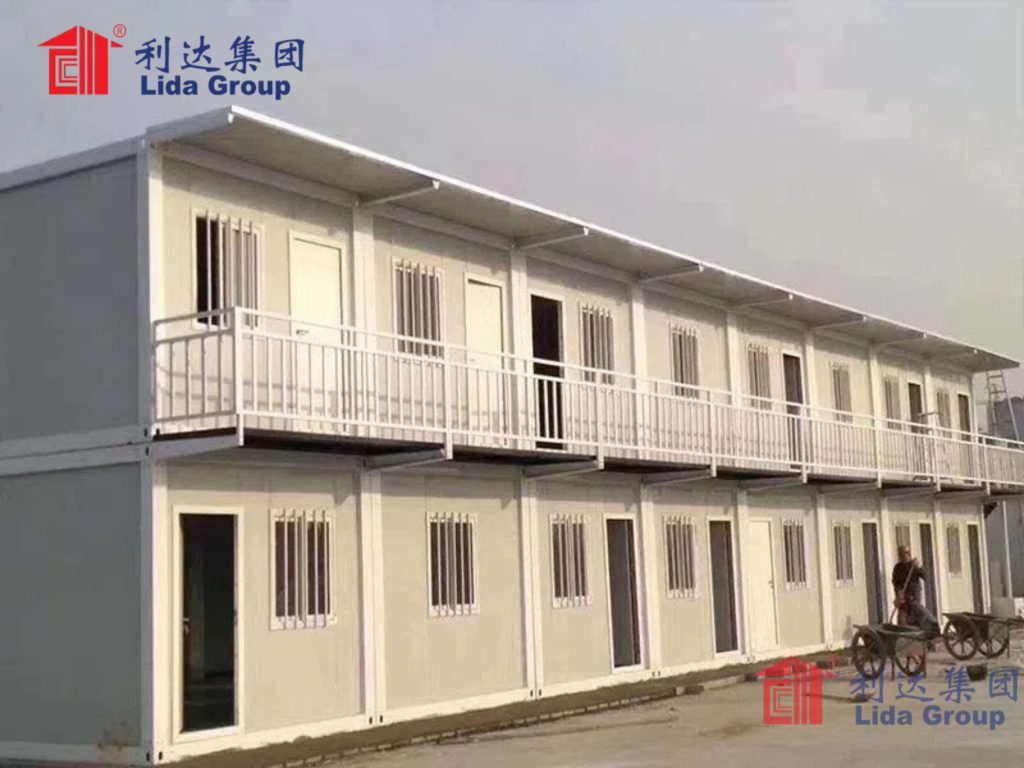
4. Key IoT Monitoring Features in Lida Group’s Container Dormitories
4.1. Environmental and Resource Monitoring
IoT sensors enable precise control over dormitory conditions and resource use:
- Climate Control: Smart thermostats adjust temperature based on occupancy (detected via motion sensors) and external weather data, reducing energy waste. For example, unoccupied rooms automatically shift to energy-saving mode.
- Air Quality Management: CO₂ and volatile organic compound (VOC) sensors trigger ventilation systems when levels exceed safe thresholds, improving indoor air quality and reducing respiratory issues among workers.
- Water and Energy Tracking: Sub-metering sensors monitor individual container or unit usage, identifying leaks, inefficient appliances, or wasteful behavior. Managers can set consumption benchmarks and receive alerts for anomalies.
- Lighting Optimization: Motion sensors and daylight harvesting adjust lighting levels, ensuring lights are only on when needed and dimming in natural light.
These features reduce operational costs by 20-30% while creating a healthier environment.
4.2. Security and Access Control
IoT integration enhances dormitory security through intelligent monitoring and response:
- Smart Access Systems: RFID cards, biometric scanners, or mobile app access replace traditional keys. The system logs all entries/exits and allows remote lock/unlock, with instant deactivation of lost credentials.
- Video Surveillance: IP cameras with motion detection and night vision stream footage to the central dashboard. AI algorithms distinguish between normal activity (e.g., workers entering) and threats (e.g., unauthorized individuals), reducing false alarms.
- Perimeter Monitoring: Sensors on fences, gates, and exterior walls detect breaches, triggering alarms and illuminating floodlights.
- Emergency Response: Panic buttons in rooms and common areas connect to security teams, with IoT data pinpointing the exact location of the alert.
These features reduce security incidents by up to 50% in pilot projects, according to Lida Group’s case studies.
4.3. Predictive Maintenance and Structural Health
IoT sensors enable proactive upkeep of dormitories, preventing costly breakdowns:
- Equipment Monitoring: Sensors track the performance of HVAC units, water heaters, and electrical panels, flagging unusual vibrations, temperature spikes, or energy use that indicate impending failure.
- Structural Sensors: Moisture sensors in walls detect leaks before they cause mold or rot, while vibration sensors identify issues with container connections or foundations.
- Preventive Maintenance Scheduling: The software generates work orders based on sensor data, ensuring maintenance (e.g., filter changes, pipe inspections) is performed before problems arise.
- Lifespan Extension: By addressing issues early, IoT monitoring extends the lifespan of dormitory components, reducing replacement costs.
A mining project using Lida Group’s system reported a 40% reduction in maintenance costs after implementing predictive monitoring.
4.4. Worker Well-Being and Safety Monitoring
IoT systems provide insights into factors affecting worker health and safety:
- Occupancy Tracking: Sensors count occupants in rooms and common areas, preventing overcrowding and ensuring compliance with safety regulations.
- Wellness Metrics: While respecting privacy, non-intrusive sensors (e.g., noise level monitors) can indicate potential issues, such as sleep disruption from excessive noise.
- Emergency Location: In case of medical emergencies, IoT data from motion sensors and access logs helps locate workers quickly.
- Evacuation Assistance: During fires or natural disasters, the system can guide workers to exits via smart lighting and send real-time updates to emergency responders.
These features demonstrate a commitment to worker welfare, improving morale and retention.
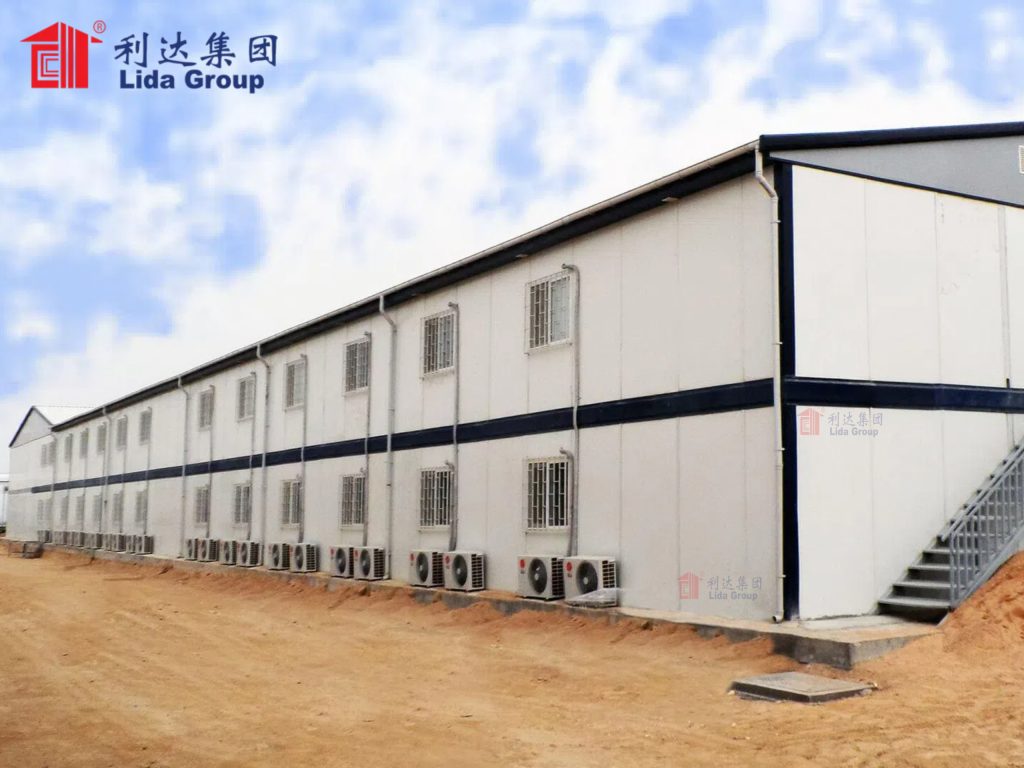
5. Benefits of IoT-Integrated Container Dormitories
5.1. Operational Efficiency and Cost Savings
The most tangible benefit is improved efficiency, with data-driven insights reducing waste and downtime:
- Energy Savings: Smart climate control and lighting reduce energy use by 25-35%, translating to thousands of dollars in annual savings for large camps.
- Reduced Maintenance Costs: Predictive maintenance cuts repair expenses by 30-40% and minimizes downtime from unexpected failures.
- Lower Labor Costs: Remote monitoring reduces the need for on-site staff, with one manager able to oversee multiple dormitory complexes.
- Water Conservation: Leak detection and usage tracking reduce water consumption by 20-25%, critical in water-scarce regions.
For example, an oil and gas project in the Middle East using Lida Group’s IoT dormitories reported $150,000 in annual energy and maintenance savings.
5.2. Enhanced Safety and Security
IoT monitoring creates a safer environment for workers and assets:
- Faster Incident Response: Real-time alerts for security breaches, fires, or medical emergencies reduce response times from hours to minutes.
- Proactive Risk Mitigation: Structural sensors identify issues like foundation shifts or electrical hazards before they cause accidents.
- Compliance with Regulations: Automated logging of safety checks, occupancy levels, and environmental conditions simplifies compliance with health and safety standards.
- Deterrence of Threats: Visible IoT security features (cameras, smart access) deter theft and unauthorized entry.
A construction project in Southeast Asia reported a 60% drop in security incidents after implementing Lida Group’s system.
5.3. Improved Worker Satisfaction and Productivity
By creating a more comfortable, responsive living environment, IoT-integrated dormitories boost worker well-being:
- Comfortable Conditions: Consistent temperature, good air quality, and adequate lighting improve sleep and reduce stress.
- Transparent Communication: Workers can access data on energy use or report issues via a mobile app, fostering a sense of involvement.
- Reduced Disruptions: Predictive maintenance minimizes unexpected outages (e.g., hot water, electricity), preventing frustration.
- Safety Assurance: Visible security measures and emergency response systems increase workers’ sense of safety.
These factors contribute to a 15-20% reduction in turnover, according to client feedback, lowering recruitment and training costs.
5.4. Data-Driven Decision-Making
IoT data provides valuable insights for long-term planning:
- Resource Allocation: Historical energy and water data helps forecast future needs, optimizing procurement.
- Design Improvements: Analysis of sensor data identifies which dormitory layouts or features perform best, informing future projects.
- Worker Behavior Trends: Data on occupancy, amenity use, or energy consumption helps tailor services (e.g., adjusting dining hours based on sleep patterns).
- Risk Assessment: Patterns in security alerts or structural issues highlight high-risk areas, enabling targeted interventions.
This data transforms dormitory management from guesswork to strategic planning.
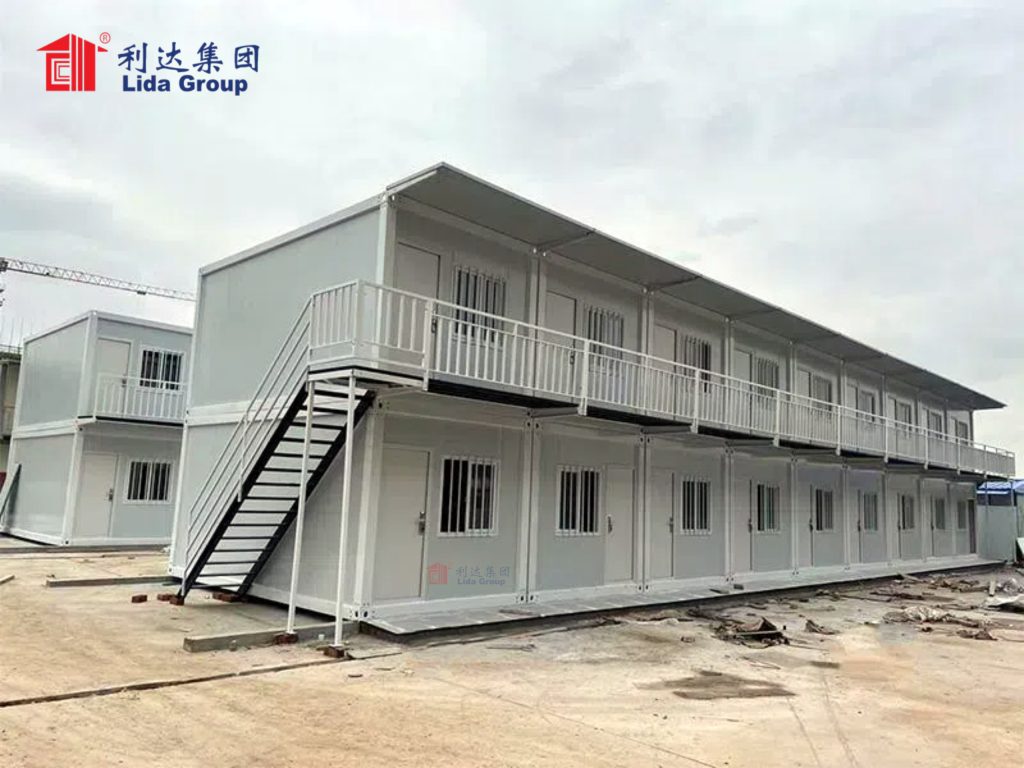
6. Real-World Applications: IoT-Integrated Dormitories in Action
6.1. Remote Mining Camp in Australia
A mining company operating in Western Australia needed to manage a dormitory complex housing 500 workers in a remote area with limited on-site staff. Lida Group installed 125 IoT-integrated container dormitories with environmental sensors, smart access, and predictive maintenance systems.
The central dashboard allowed managers in Perth (1,000 km away) to monitor energy use, detect leaks, and respond to security alerts. Predictive analytics identified an impending HVAC failure in 30 units, enabling proactive repairs during a scheduled shutdown—avoiding a costly emergency. Energy sensors revealed that unoccupied rooms were using 40% more power than expected, leading to the implementation of auto-shutdown protocols that cut energy costs by $80,000 annually. Workers reported higher satisfaction with consistent temperatures and faster response to maintenance requests.
6.2. Construction Project in the United Arab Emirates
A construction firm building a new airport in Dubai required a secure, efficient dormitory for 300 workers, with strict compliance to health and safety regulations. Lida Group’s solution included 75 container dormitories with air quality sensors, smart access, and emergency response systems.
Air quality sensors detected high CO₂ levels in shared spaces, triggering increased ventilation and preventing respiratory issues. Access logs ensured compliance with labor laws (e.g., tracking rest periods), while video surveillance deterred theft. During a minor fire in a kitchenette, smoke detectors and heat sensors alerted security within 30 seconds, allowing a quick response that minimized damage. The project manager noted that IoT data simplified audits, with regulators praising the transparency of the monitoring system.
6.3. Renewable Energy Project in Scandinavia
A wind farm developer in Norway needed to house 150 technicians in a harsh climate, where extreme cold and limited daylight posed challenges. Lida Group’s container dormitories included temperature sensors, occupancy tracking, and structural health monitors.
IoT data showed that heating systems were overworking in unoccupied rooms, leading to the installation of motion-based controls that reduced energy use by 35%. Structural sensors detected ice buildup on roofs, triggering automated de-icing systems and preventing damage. Workers used a mobile app to adjust room temperatures and report issues, with 90% of maintenance requests resolved within 24 hours. The developer reported a 25% reduction in operational costs and a 10% drop in absenteeism due to improved living conditions.
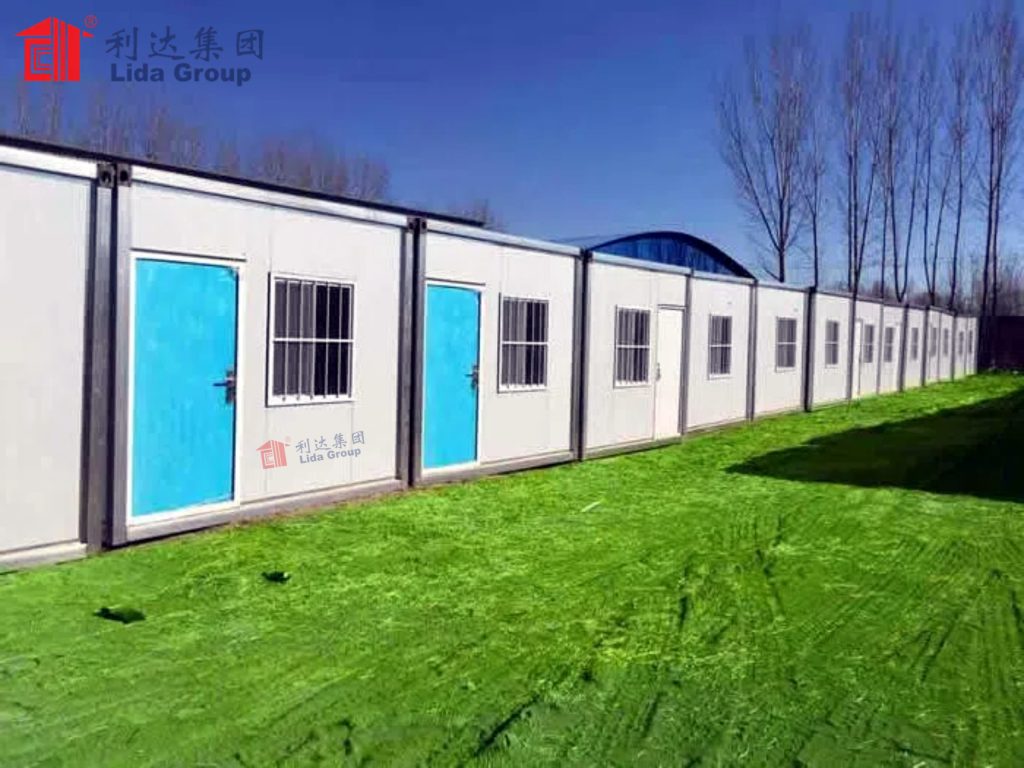
7. Challenges and Solutions in Implementing IoT-Integrated Dormitories
7.1. Connectivity in Remote Locations
Poor or unreliable internet in remote areas can disrupt data transmission. Lida Group addresses this with:
- Hybrid Connectivity: Combining cellular, satellite, and Wi-Fi to ensure redundancy. In areas with no coverage, edge devices store data locally and sync when networks are available.
- Low-Bandwidth Optimization: Sensors transmit compressed data, reducing bandwidth needs. Non-critical data (e.g., historical energy use) is sent in batches during off-peak hours.
- Solar-Powered Nodes: Weather-resistant, solar-powered Wi-Fi nodes extend coverage in large remote complexes, ensuring all containers connect to the network.
7.2. Data Security and Privacy Concerns
IoT systems collect sensitive data, raising risks of breaches or misuse. Solutions include:
- End-to-End Encryption: All data transmission between sensors, dashboards, and cloud servers is encrypted, preventing interception.
- Access Controls: Role-based permissions ensure only authorized personnel can view sensitive data (e.g., worker access logs).
- Anonymization: Worker-related data (e.g., occupancy) is anonymized to protect privacy, with individual tracking limited to emergency situations.
- Compliance with Regulations: Systems are designed to meet data protection laws (e.g., GDPR, CCPA), with features like data retention limits and user consent tools.
7.3. Cost of IoT Integration
The upfront cost of sensors, software, and connectivity can be a barrier. Lida Group mitigates this by:
- Phased Implementation: Offering basic IoT packages (e.g., only security and energy monitoring) with options to add features later as budgets allow.
- ROI Calculators: Providing clients with tools to project savings from energy efficiency, reduced maintenance, and lower labor costs, typically showing payback within 2-3 years.
- Scalable Licensing: Software fees based on the number of containers or sensors, avoiding overpayment for unused capacity.
- Partnerships with Tech Providers: Collaborating with IoT hardware and software companies to offer bundled, discounted solutions.
7.4. User Adoption and Training
Workers and managers may resist new technology due to unfamiliarity. Lida Group provides:
- Simplified Interfaces: User-friendly dashboards and apps with intuitive design, requiring minimal training.
- On-Site Training: Work
shops and hands-on sessions for on-site staff and workers, covering basic operations like adjusting smart thermostats or reporting issues via the app.
- Support Resources: Detailed manuals, video tutorials, and a 24/7 helpdesk to assist with troubleshooting.
- Worker Engagement: Involving workers in the rollout process, such as testing the app and providing feedback, to increase buy-in and familiarity.
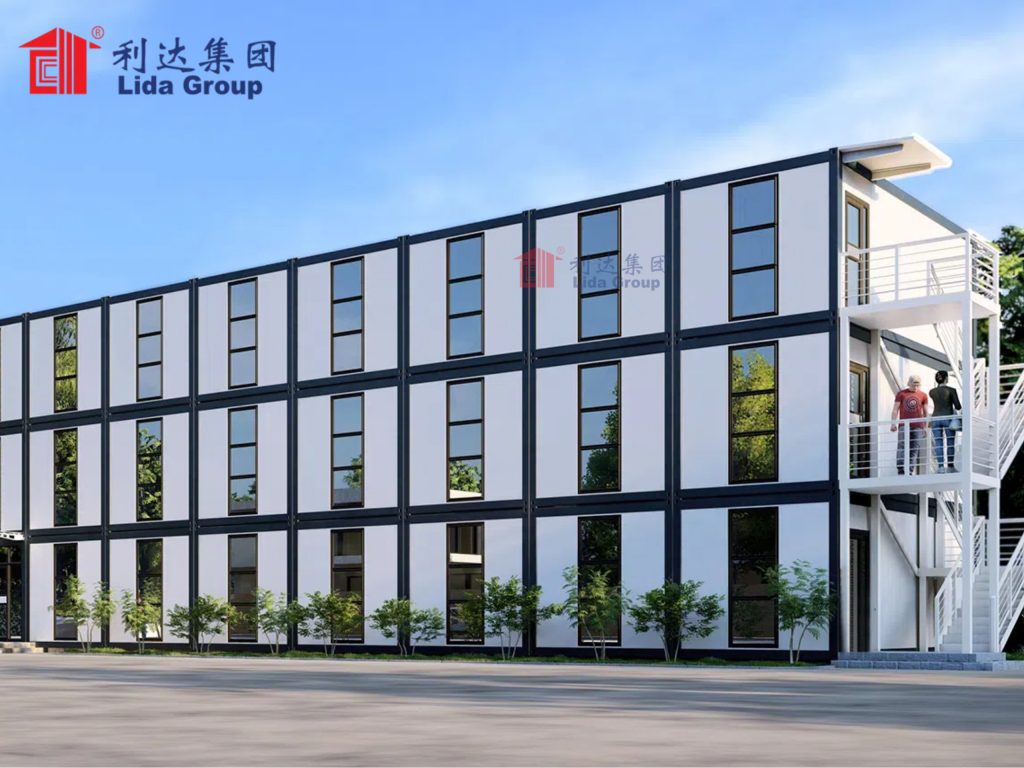
8. Future Trends in IoT-Integrated Container Dormitories
8.1. AI-Driven Autonomy
Future systems will leverage advanced artificial intelligence to enable self-optimizing dormitories:- Autonomous Resource Management: AI will automatically adjust lighting, heating, and ventilation based on real-time occupancy, weather, and worker preferences, eliminating the need for manual input.
- Predictive Maintenance 2.0: Machine learning models will refine predictions by incorporating external data (e.g., local climate patterns, equipment manufacturer updates) to forecast issues with greater accuracy.
- Adaptive Security: AI-powered cameras will recognize individual workers, eliminating the need for access cards, and distinguish between routine events (e.g., a worker carrying tools) and threats, further reducing false alarms.
8.2. Integration with Wearable Technology
Connectivity between dormitory IoT systems and worker wearables will enhance safety and well-being:- Health Monitoring: Wearables (e.g., smartwatches) will share data on workers’ heart rates or fatigue levels with the dormitory system, which can then adjust room conditions (e.g., dimming lights for rest) or alert managers to potential health risks.
- Location Tracking for Emergencies: In large dormitory complexes, wearables will pinpoint workers’ locations during emergencies, enabling faster rescue efforts.
- Personalized Comfort: Wearables will sync with dormitory systems to adjust temperature or lighting based on individual preferences, creating a customized living environment.
8.3. Sustainability-Focused Innovations
IoT integration will deepen its role in reducing environmental impact:- Carbon Footprint Tracking: Sensors will measure not just energy use but also the carbon emissions associated with dormitory operations, providing data to meet net-zero goals.
- Smart Grid Integration: Dormitories will connect to local smart grids, enabling demand response (e.g., reducing energy use during peak grid load) and earning credits for excess solar energy generated on-site.
- Circular Resource Management: IoT systems will monitor material usage and waste production, optimizing recycling programs and tracking the lifecycle of dormitory components to maximize reuse.
8.4. Enhanced Interconnectivity with Project Ecosystems
Dormitories will become central nodes in broader project networks:- Supply Chain Integration: IoT data on worker numbers and schedules will inform on-site catering and supply deliveries, reducing waste from overstocking.
- Weather Adaptation: Dormitory systems will sync with weather forecasting tools to pre-emptively adjust conditions (e.g., reinforcing insulation before a cold snap) or alert workers to safety risks (e.g., high winds).
- Cross-Site Benchmarking: Data from multiple dormitory complexes will be aggregated to identify best practices, with AI suggesting optimizations based on performance at other sites.
9. Conclusion
Lida Group’s integration of IoT monitoring into container worker dormitories through smart prefab building systems marks a pivotal shift in how temporary worker accommodation is designed, managed, and experienced. By combining robust hardware infrastructure, advanced software analytics, and seamless connectivity, these dormitories transform passive living spaces into active, data-driven environments that enhance efficiency, safety, and worker well-being.The benefits are clear and far-reaching: operational costs reduced by 20-35% through optimized resource use; security incidents cut by up to 60% via real-time monitoring and rapid response; and worker turnover lowered by 15-20% due to improved comfort and safety. Real-world applications in remote mining camps, urban construction sites, and harsh climate zones validate the effectiveness of these systems, demonstrating their adaptability to diverse environments.Challenges such as connectivity gaps, data security concerns, and cost barriers are effectively addressed through innovative solutions—hybrid connectivity, end-to-end encryption, phased implementation—ensuring that IoT integration is accessible and reliable even in the most demanding settings. As technology evolves, future advancements in AI autonomy, wearable integration, and sustainability-focused features will further elevate these dormitories, making them even more responsive and efficient.In essence, Lida Group’s IoT-integrated container dormitories are more than just housing—they are a cornerstone of future-ready work sites. By leveraging the power of data and connectivity, they enable industries to prioritize both operational excellence and worker welfare, setting a new standard for temporary accommodation in the digital age. As organizations increasingly recognize the value of smart, connected systems, these dormitories will play a critical role in building more efficient, safe, and human-centric work environments worldwide.

Related news
-
Luxury Temporary Living: High-Quality Container Houses by Lida Group Transform Worker Dormitory Expectations with Prefab Amenities
2025-08-22 16:24:09
-
Sustainable Labor Camps: Lida Group's High-Quality Container Houses Reduce Carbon Footprint 35% with Solar-Ready Prefab Roofs
2025-08-22 13:36:15
-
Vertical Camp Innovation: Multi-Story Container Worker Dormitories Maximize Space via Lida Group's Prefab Building Engineering
2025-08-21 17:43:51
contact us
- Tel: +86-532-88966982
- Whatsapp: +86-13793209022
- E-mail: sales@lidajituan.com


